Belongs to the Greek alphabet, mu(μ) and nu(ν) symbols are frequently used in mathematics and physics.
There are several ways to use these symbols in LaTeX, all of which we will discuss in this tutorial.
Use mu(μ) symbol in LaTeX
LaTeX provides a default command to print mu symbol in a LaTeX document, which is \mu.
This command is used in math mode so if you want to use this symbol in inline mode you have to use single dollar $\mu$.
\documentclass{article}
\usepackage{amsmath} % for \longrightarrow
\begin{document}
\[ \verb|\mu|\longrightarrow \mu \]
\[ \textbf{m}=\frac{1}{\mu_0}\textbf{B}_r V \]
\[ (\exists\mu^2)(\forall f^\prime) \]
\[ \sum^n_{i=1}\frac{1}{\mu_i}dN_i \]
\[ 1\mu m \quad 2\mu m \quad 3\mu m \]
\end{document}Output :
Non-italic mu symbol in text mode
In above example, you can see output of \mu command is shown in italic font.
If you want to use non-italic mu symbol in text mode, LaTeX provides a default command called \textmu.
This command allows you to print this symbol in a LaTeX document in a non-italic font.
\documentclass{article}
\usepackage{amsmath} % for \longrightarrow
\begin{document}
\verb|\mu|$\longleftrightarrow \mu$\\[4pt]
\verb|\textmu|$\longrightarrow$ \textmu\\[4pt]
1\textmu m 2\textmu m 3\textmu m\\[4pt]
Write \textmu\;in text mode
\end{document}Output :
Non-italic mu symbol in math mode
You need the upgreek package to use non-italic mu symbol in latex math mode.
This package provides a command called \upmu. With this command, you can print symbol in the document.
You can also use \muup command included in txfonts package. There are slight differences between output of these two commands.
So, you can use either one as per your need.
\documentclass{article}
\usepackage{amsmath} % for \longrightarrow
\usepackage{upgreek} % for \upmu
\usepackage{txfonts} % for \muup
\begin{document}
\[ \verb|\mu|\longrightarrow\mu \quad\verb|[Default]| \]
\[ \verb|\upmu|\longrightarrow\upmu \quad\verb|[upgreek]| \]
\[ \verb|\muup|\longrightarrow\muup \quad\verb|[txfonts]| \]
\[ (\upmu_0,\upmu_1,\dots,\upmu_{(n-1)},\upmu_n)\quad\verb|[upgreek]| \]
\[ \muup(E)+\muup(\O) \quad\verb|[txfonts]| \]
\[ \sum^\infty_{n=1}\upmu(E_k) \quad\verb|[upgreek]| \]
\end{document}Output :
Use nu(ν) symbol in LaTeX
To print nu symbol in a latex document you need to use \nu command. This is LaTeX’s default command.
To use this command in inline mode you must use single dollar quotation $\nu$.
\documentclass{article}
\usepackage{amsmath} % for \longrightarrow
\begin{document}
\[ \verb|\nu|\longrightarrow\nu \]
\[ \nu =\frac{\mu}{\rho} \]
\[ \tilde{\nu}=\frac{1}{\lambda} \]
\[ (\nu_0,\nu_1,\dots,\nu_{(n-1)},\nu_n \]
\[ \nu^{\text{Hencky}}=-\frac{\ln\lambda_{\text{trans}}}{\ln\lambda_{\text{axial}}} \]
\end{document}Output :
Upright nu symbol in LaTeX
First of all, you need to use upgreek package for upright nu symbol. You can print this symbol in a latex document with \upnu command included in this package.
\documentclass{article}
\usepackage{amsmath} % for \longrightarrow
\usepackage{upgreek} % for \upnu
\begin{document}
\[ \verb|\nu|\longrightarrow\nu \]
\[ \verb|\upnu|\longrightarrow\upnu \]
\[ \tilde{\upnu}=\frac{1}{\lambda} \]
\[ (\upnu_0,\upnu_1,\dots,\upnu_{(n-1)},\upnu_n \]
\end{document}Output :
Bold mu and nu symbol
The best package to bold a symbol is bm. This package provides you with one command, which is \bm{}.
With this command, you can print any symbol in bold font.
\documentclass{article}
\usepackage{amsmath} % for \longrightarrow
\usepackage{upgreek} % for \upnu
\usepackage{bm} % for bold symbol
\begin{document}
\[ \verb|\mu|\longrightarrow\mu \]
\[ \verb|\bm{\mu}|\longrightarrow\bm{\mu} \]
\[ \verb|\upmu|\longrightarrow\upmu \]
\[ \verb|\bm{\upmu}|\longrightarrow\bm{\upmu} \]
\[ \verb|\nu|\longrightarrow\nu \]
\[ \verb|\bm{\nu}|\longrightarrow\bm{\nu} \]
\[ \verb|\upnu|\longrightarrow\upnu \]
\[ \verb|\bm{\upnu}|\longrightarrow\bm{\upnu} \]
\end{document}Output :
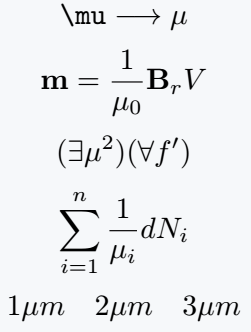
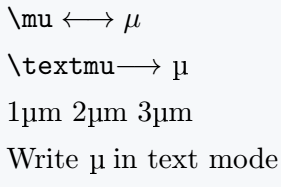
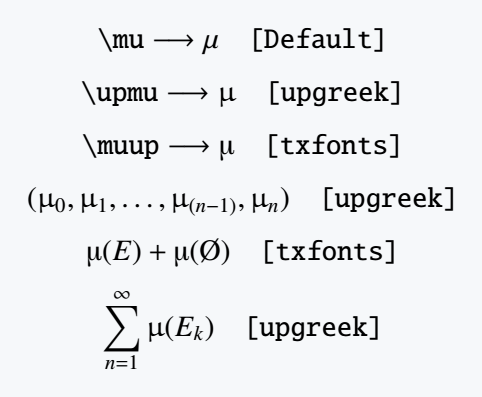
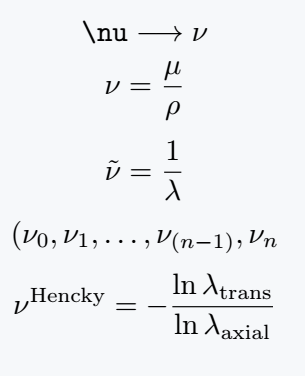
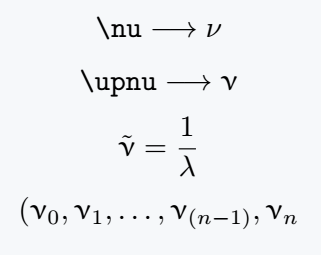
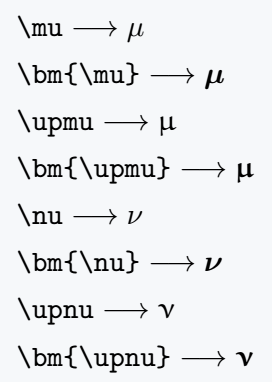
You are the best!
Thank You.